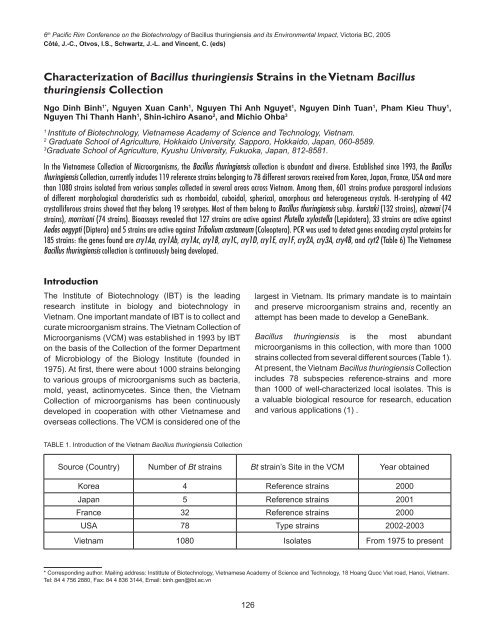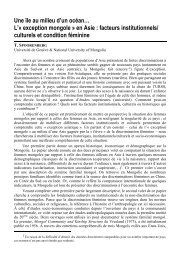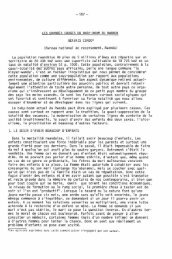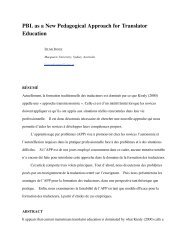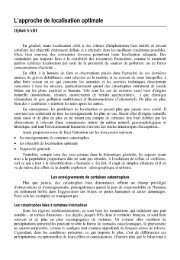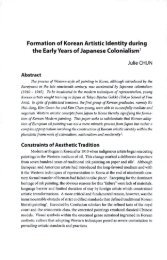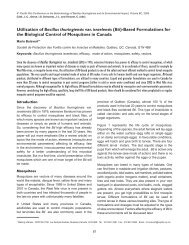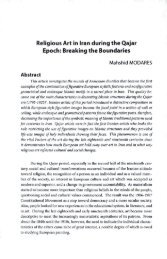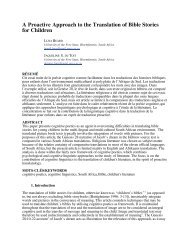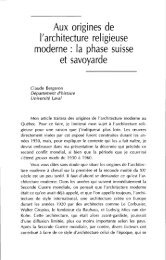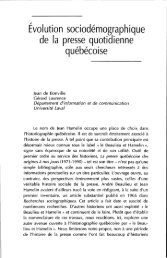Characterization of Bacillus thuringiensis Strains in the Vietnam ...
Characterization of Bacillus thuringiensis Strains in the Vietnam ...
Characterization of Bacillus thuringiensis Strains in the Vietnam ...
Create successful ePaper yourself
Turn your PDF publications into a flip-book with our unique Google optimized e-Paper software.
6 th Pacific Rim Conference on <strong>the</strong> Biotechnology <strong>of</strong> <strong>Bacillus</strong> <strong>thur<strong>in</strong>giensis</strong> and its Environmental Impact, Victoria BC, 2005<br />
Côté, J.-C., Otvos, I.S., Schwartz, J.-L. and V<strong>in</strong>cent, C. (eds)<br />
<strong>Characterization</strong> <strong>of</strong> <strong>Bacillus</strong> <strong>thur<strong>in</strong>giensis</strong> <strong>Stra<strong>in</strong>s</strong> <strong>in</strong> <strong>the</strong> <strong>Vietnam</strong> <strong>Bacillus</strong><br />
<strong>thur<strong>in</strong>giensis</strong> Collection<br />
Ngo D<strong>in</strong>h B<strong>in</strong>h 1* , Nguyen Xuan Canh 1 , Nguyen Thi Anh Nguyet 1 , Nguyen D<strong>in</strong>h Tuan 1 , Pham Kieu Thuy 1 ,<br />
Nguyen Thi Thanh Hanh 1 , Sh<strong>in</strong>-ichiro Asano 2 , and Michio Ohba 3<br />
1 Institute <strong>of</strong> Biotechnology, <strong>Vietnam</strong>ese Academy <strong>of</strong> Science and Technology, <strong>Vietnam</strong>.<br />
2 Graduate School <strong>of</strong> Agriculture, Hokkaido University, Sapporo, Hokkaido, Japan, 060-8589.<br />
3 Graduate School <strong>of</strong> Agriculture, Kyushu University, Fukuoka, Japan, 812-8581.<br />
In <strong>the</strong> <strong>Vietnam</strong>ese Collection <strong>of</strong> Microorganisms, <strong>the</strong> <strong>Bacillus</strong> <strong>thur<strong>in</strong>giensis</strong> collection is abundant and diverse. Established s<strong>in</strong>ce 1993, <strong>the</strong> <strong>Bacillus</strong><br />
<strong>thur<strong>in</strong>giensis</strong> Collection, currently <strong>in</strong>cludes 119 reference stra<strong>in</strong>s belong<strong>in</strong>g to 78 different serovars received from Korea, Japan, France, USA and more<br />
than 1080 stra<strong>in</strong>s isolated from various samples collected <strong>in</strong> several areas across <strong>Vietnam</strong>. Among <strong>the</strong>m, 601 stra<strong>in</strong>s produce parasporal <strong>in</strong>clusions<br />
<strong>of</strong> different morphological characteristics such as rhomboidal, cuboidal, spherical, amorphous and heterogeneous crystals. H-serotyp<strong>in</strong>g <strong>of</strong> 442<br />
crystalliferous stra<strong>in</strong>s showed that <strong>the</strong>y belong 19 serotypes. Most <strong>of</strong> <strong>the</strong>m belong to <strong>Bacillus</strong> <strong>thur<strong>in</strong>giensis</strong> subsp. kurstaki (132 stra<strong>in</strong>s), aizawai (74<br />
stra<strong>in</strong>s), morrisoni (74 stra<strong>in</strong>s). Bioassays revealed that 127 stra<strong>in</strong>s are active aga<strong>in</strong>st Plutella xylostella (Lepidotera), 33 stra<strong>in</strong>s are active aga<strong>in</strong>st<br />
Aedes aegypti (Diptera) and 5 stra<strong>in</strong>s are active aga<strong>in</strong>st Tribolium castaneum (Coleoptera). PCR was used to detect genes encod<strong>in</strong>g crystal prote<strong>in</strong>s for<br />
185 stra<strong>in</strong>s: <strong>the</strong> genes found are cry1Aa, cry1Ab, cry1Ac, cry1B, cry1C, cry1D, cry1E, cry1F, cry2A, cry3A, cry4B, and cyt2 (Table 6) The <strong>Vietnam</strong>ese<br />
<strong>Bacillus</strong> <strong>thur<strong>in</strong>giensis</strong> collection is cont<strong>in</strong>uously be<strong>in</strong>g developed.<br />
Introduction<br />
The Institute <strong>of</strong> Biotechnology (IBT) is <strong>the</strong> lead<strong>in</strong>g<br />
research <strong>in</strong>stitute <strong>in</strong> biology and biotechnology <strong>in</strong><br />
<strong>Vietnam</strong>. One important mandate <strong>of</strong> IBT is to collect and<br />
curate microorganism stra<strong>in</strong>s. The <strong>Vietnam</strong> Collection <strong>of</strong><br />
Microorganisms (VCM) was established <strong>in</strong> 1993 by IBT<br />
on <strong>the</strong> basis <strong>of</strong> <strong>the</strong> Collection <strong>of</strong> <strong>the</strong> former Department<br />
<strong>of</strong> Microbiology <strong>of</strong> <strong>the</strong> Biology Institute (founded <strong>in</strong><br />
1975). At first, <strong>the</strong>re were about 1000 stra<strong>in</strong>s belong<strong>in</strong>g<br />
to various groups <strong>of</strong> microorganisms such as bacteria,<br />
mold, yeast, act<strong>in</strong>omycetes. S<strong>in</strong>ce <strong>the</strong>n, <strong>the</strong> <strong>Vietnam</strong><br />
Collection <strong>of</strong> microorganisms has been cont<strong>in</strong>uously<br />
developed <strong>in</strong> cooperation with o<strong>the</strong>r <strong>Vietnam</strong>ese and<br />
overseas collections. The VCM is considered one <strong>of</strong> <strong>the</strong><br />
TABLE 1. Introduction <strong>of</strong> <strong>the</strong> <strong>Vietnam</strong> <strong>Bacillus</strong> <strong>thur<strong>in</strong>giensis</strong> Collection<br />
* Correspond<strong>in</strong>g author. Mail<strong>in</strong>g address: Instittute <strong>of</strong> Biotechnology, <strong>Vietnam</strong>ese Academy <strong>of</strong> Science and Technology, 18 Hoang Quoc Viet road, Hanoi, <strong>Vietnam</strong>.<br />
Tel: 84 4 756 2880, Fax: 84 4 836 3144, Email: b<strong>in</strong>h.gen@ibt.ac.vn<br />
126<br />
largest <strong>in</strong> <strong>Vietnam</strong>. Its primary mandate is to ma<strong>in</strong>ta<strong>in</strong><br />
and preserve microorganism stra<strong>in</strong>s and, recently an<br />
attempt has been made to develop a GeneBank.<br />
<strong>Bacillus</strong> <strong>thur<strong>in</strong>giensis</strong> is <strong>the</strong> most abundant<br />
microorganisms <strong>in</strong> this collection, with more than 1000<br />
stra<strong>in</strong>s collected from several different sources (Table 1).<br />
At present, <strong>the</strong> <strong>Vietnam</strong> <strong>Bacillus</strong> <strong>thur<strong>in</strong>giensis</strong> Collection<br />
<strong>in</strong>cludes 78 subspecies reference-stra<strong>in</strong>s and more<br />
than 1000 <strong>of</strong> well-characterized local isolates. This is<br />
a valuable biological resource for research, education<br />
and various applications (1) .<br />
Source (Country) Number <strong>of</strong> Bt stra<strong>in</strong>s Bt stra<strong>in</strong>’s Site <strong>in</strong> <strong>the</strong> VCM Year obta<strong>in</strong>ed<br />
Korea 4 Reference stra<strong>in</strong>s 2000<br />
Japan 5 Reference stra<strong>in</strong>s 2001<br />
France 32 Reference stra<strong>in</strong>s 2000<br />
USA 78 Type stra<strong>in</strong>s 2002-2003<br />
<strong>Vietnam</strong> 1080 Isolates From 1975 to present
The characteristics <strong>of</strong> isolates <strong>in</strong> <strong>the</strong> <strong>Vietnam</strong><br />
collection <strong>of</strong> <strong>Bacillus</strong> <strong>thur<strong>in</strong>giensis</strong> isolation<br />
Several Bt-based bio<strong>in</strong>secticides are available on <strong>the</strong><br />
<strong>Vietnam</strong>ese market, most <strong>of</strong> which are imported. Us<strong>in</strong>g<br />
imported products may br<strong>in</strong>g foreign and recomb<strong>in</strong>ant<br />
bacteria <strong>in</strong>to <strong>the</strong> local ecosystem. This may also causes<br />
<strong>the</strong> change <strong>of</strong> local microorganisms distribution (1).<br />
Accord<strong>in</strong>gly, it is necessary to study <strong>the</strong> distribution and<br />
<strong>the</strong> contribution <strong>of</strong> <strong>the</strong> local native <strong>Bacillus</strong> <strong>thur<strong>in</strong>giensis</strong><br />
bacteria. Bt has been isolated from numerous types<br />
<strong>of</strong> samples collected across <strong>Vietnam</strong>, <strong>in</strong>clud<strong>in</strong>g 550<br />
soil, 185 leaf and 45 <strong>in</strong>sect-cadaver samples. Isolation<br />
procedures were implemented follow<strong>in</strong>g a method<br />
improved from Ohba and Aizawai (1986) (10) (Table 2).<br />
TABLE 2. Characteristics <strong>of</strong> <strong>Bacillus</strong> <strong>thur<strong>in</strong>giensis</strong> isolates <strong>in</strong> <strong>Vietnam</strong>.<br />
K<strong>in</strong>d<br />
<strong>of</strong><br />
samples<br />
Number <strong>of</strong> samples<br />
with Bt/ Number <strong>of</strong><br />
samples exam<strong>in</strong>ed<br />
(%)<br />
Number <strong>of</strong> Bt isolated/<br />
Number <strong>of</strong> spore-form<strong>in</strong>g<br />
bacteria exam<strong>in</strong>ed (Bt<br />
<strong>in</strong>dex)<br />
Soils 379/550 (68.91) 763/1861 (0.41)<br />
leaves 104/185 (56.22) 258/662 (0.39)<br />
Insect<br />
cadavers<br />
16/45 (35.56) 59/190 (0.31)<br />
Total 499/780 (63.97) 1080/2713(0.4)<br />
The isolation process obta<strong>in</strong>ed 2713 colonies with<br />
morphological features <strong>of</strong> <strong>the</strong> <strong>Bacillus</strong> cereus group,<br />
<strong>of</strong> which 1080 colonies were identified as crystalproduc<strong>in</strong>g<br />
Bt. Bt was present <strong>in</strong> 499 samples (63.97%),<br />
and an average Bt-<strong>in</strong>dex <strong>of</strong> 0.4. <strong>Bacillus</strong> <strong>thur<strong>in</strong>giensis</strong><br />
was found <strong>in</strong> all three k<strong>in</strong>ds <strong>of</strong> samples, <strong>in</strong>clud<strong>in</strong>g soil,<br />
leaves and <strong>in</strong>sect cadavers. However, <strong>the</strong>ir prevalence<br />
differed depend<strong>in</strong>g on k<strong>in</strong>d <strong>of</strong> samples, i.e. highest<br />
(68.9%) <strong>in</strong> <strong>the</strong> soil and lowest (35.5%) <strong>in</strong> <strong>in</strong>sect cadavers<br />
(Table 2).<br />
Morphological characteristics <strong>of</strong> toxic<br />
crystal prote<strong>in</strong><br />
The isolation process resulted <strong>in</strong> 1080 stra<strong>in</strong>s produc<strong>in</strong>g<br />
crystal prote<strong>in</strong>s with various size and morphological<br />
characteristics. Three shapes <strong>of</strong> crystals were abundant:<br />
rhomboidal (63.1%), spherical (11.2%), and cuboidal<br />
crystals (4.8%). Some (5.8%) stra<strong>in</strong>s produce irregular<br />
crystals. Most <strong>of</strong> isolates produce only one specific<br />
127<br />
TABLE 3. Morphology <strong>of</strong> Bt crystal <strong>in</strong> <strong>the</strong> Collection.<br />
Crystal shapes Number <strong>of</strong> stra<strong>in</strong>s Percentage (%)<br />
Rhomboidal 681 63.1<br />
Spherical 121 11.2<br />
Cuboidal 52 4.8<br />
Heterogeneous 163 15.1<br />
Amorphous 63 5.8<br />
FIG. 1. Scann<strong>in</strong>g electron micrographs <strong>of</strong> crystal morphology <strong>of</strong> Bt<br />
isolates. a: Stra<strong>in</strong> DB 21-2 isolated from Dien Bien Phu soil sample<br />
with rhomboidal crystals; b: Stra<strong>in</strong> HN5-7 isolated from Ha Noi with<br />
spherical crystals; c: Stra<strong>in</strong> SH149-11 isolated from Ha Tay prov<strong>in</strong>ce<br />
with cuboidal crystals; d: Stra<strong>in</strong> NC29-3 isolated from Thai Nguyen<br />
prov<strong>in</strong>ce with cuboidal and rhomboidal crystals; e: Stra<strong>in</strong> TN 1-1<br />
isolated from Thai Nguyen prov<strong>in</strong>ce with rhomboidal and spherical<br />
crystals; g: Stra<strong>in</strong> NC27-1 isolated from <strong>the</strong> Thai Nguyen prov<strong>in</strong>ce<br />
with cuboidal and spherical crystals.<br />
k<strong>in</strong>d <strong>of</strong> crystal, but some (15.1%) are able to produce<br />
crystals with various shapes (Figure 1, Table 3).<br />
Classification characteristics <strong>of</strong> Bt <strong>in</strong> <strong>the</strong><br />
collection<br />
A number <strong>of</strong> stra<strong>in</strong>s (119) belong<strong>in</strong>g to 78 Bt subspecies<br />
were obta<strong>in</strong>ed from various countries, <strong>in</strong>clud<strong>in</strong>g <strong>the</strong><br />
USA, France, Japan, and Korea. With <strong>the</strong>se reference<br />
stra<strong>in</strong>s, a set <strong>of</strong> antisera was produced for use as a<br />
standard serological kit to classify Bt. Isolated stra<strong>in</strong>s<br />
<strong>in</strong> <strong>the</strong> VCM were classified accord<strong>in</strong>g to de Barjac and<br />
Bonnefoi (1990) (6) (Table 4).<br />
Of 479 stra<strong>in</strong>s classified by flagellar (H) antigen analysis,<br />
442 stra<strong>in</strong>s (92.3%) showed positive agglut<strong>in</strong>ation with<br />
18 antisera, <strong>the</strong> rema<strong>in</strong><strong>in</strong>g 37 stra<strong>in</strong>s (7.7%) did not<br />
agglut<strong>in</strong>ate with any <strong>of</strong> 60 antisera used. The results<br />
revealed that 27.6% <strong>of</strong> <strong>the</strong> isolates belong to serotypes<br />
3a,3b,3c (subspecies kurstaki), 15.4% belong to
TABLE 4. H-Serotyp<strong>in</strong>g <strong>of</strong> <strong>Bacillus</strong> <strong>thur<strong>in</strong>giensis</strong> isolates <strong>in</strong> <strong>Vietnam</strong> Bt Collection.<br />
No Subspecies H-serotype Agglut<strong>in</strong>ation stra<strong>in</strong>s Percentage (%)<br />
1 alesti 3a, 3c 35 7.3<br />
2 sumiyoshiensis 3a, 3d 6 1.3<br />
3 kurstaki 3a, 3b, 3c 132 27.6<br />
4 fukuokaensis 3a, 3d, 3e 18 3.8<br />
5 gallariae 5a, 5b 7 1.5<br />
6 aizawai 7 74 15.4<br />
7 morrisoni 8a, 8b 74 15.4<br />
8 nigeriensis 8b, 8d 16 3.3<br />
9 tolwothy 9 13 2.7<br />
10 isralensis 14 7 1.5<br />
11 <strong>in</strong>diana 16 13 2.5<br />
12 yunnanensis 20a, 20b 4 0.8<br />
13 pondicheriensis 20a, 20c 3 0.6<br />
14 colmeri 21 12 2.5<br />
15 novosibirsk 24a, 24c 3 0.6<br />
16 coreanensis 25 6 1.3<br />
17 leesis 33 8 1.7<br />
18 konkukian 34 11 2.3<br />
19 Not agglut<strong>in</strong>ated 37 7.7<br />
TABLE 5. Toxicity <strong>of</strong> <strong>Bacillus</strong> <strong>thur<strong>in</strong>giensis</strong> isolates aga<strong>in</strong>st Plutella xylostella, Aedes aegypti, and Tribolium castaneum, 3 days after treatment.<br />
Percentage <strong>of</strong><br />
died <strong>in</strong>sects (%)<br />
0-20<br />
20-40<br />
40-60<br />
60-80<br />
80-100<br />
Dosages<br />
(spores/ml)<br />
Plutella xylostella Aedes aegypti Tribolium castaneum<br />
No. <strong>of</strong> Bt<br />
stra<strong>in</strong>s<br />
Percentage (%)<br />
128<br />
No <strong>of</strong> Bt<br />
stra<strong>in</strong>s<br />
Percentage (%)<br />
No <strong>of</strong> Bt<br />
stra<strong>in</strong>s<br />
Percentage (%)<br />
10 5 49 15.2 33 22.4 39 40.6<br />
10 7 20 6.2 9 6.1 31 32.3<br />
10 5 81 25.2 48 32.7 25 26<br />
10 7 39 12.1 38 25.8 23 24<br />
10 5 76 23.6 36 24.5 18 18.8<br />
10 7 127 39.4 43 29.3 22 23<br />
10 5 68 21.1 21 14.3 11 11.5<br />
10 7 77 23.9 36 24.5 17 17.7<br />
10 5 48 14.9 9 6.1 3 3.1<br />
10 7 59 18.3 21 14.3 5 5.2
FIG. 2. Agarose gel (1.5%) electrophoresis analysis <strong>of</strong> multiplex PCR products obta<strong>in</strong>ed by us<strong>in</strong>g specific primers <strong>of</strong> Bt isolates. Lane M:<br />
Marker, Lane 1: SPJ9-6, Lane 2: DB8-2, Lane 3: HL2-1, Lane 4: DB6-2, Lane 5: SP23-10, Lane 6: BB12-6, Lane 7: SP5-1, Lane 8: NA8-1, Lane<br />
9: QB3-2, Lane 10: SP10-7, Lane 11: DH206-2, Lane 12: TQ3-3, Lane 13: SP14-3, Lane 14: AV132-2, Lane 15: BB85-14, Lane 16: NAK7-4.<br />
TABLE 6. PCR analysis <strong>of</strong> <strong>the</strong> <strong>in</strong>secticidal crystal prote<strong>in</strong> genes from <strong>Bacillus</strong> <strong>thur<strong>in</strong>giensis</strong> isolates.<br />
Specific primer No. <strong>of</strong> isolates detected % <strong>of</strong> isolates detected<br />
cry1Aa 112 60.5<br />
cry1Ab 114 61.6<br />
cry1Ac 124 67<br />
cry1B 28 15.1<br />
cry1C 43 23.2<br />
cry1D 36 19.5<br />
cry1E 26 14.1<br />
cry1F 20 10.8<br />
cry2A 77 41.6<br />
cry3A 3 1.6<br />
cry4B 16 8.7<br />
cyt2 65 35.1<br />
Not detected 13 7<br />
aizawai and 15.4% belong to morrisoni. Subspecies<br />
novosibirsk and pondicheriensis were rare subspecies,<br />
with 3 stra<strong>in</strong>s (0.6%) <strong>of</strong> each. Our data <strong>in</strong>dicate that Bt<br />
isolated <strong>in</strong> <strong>Vietnam</strong> is ra<strong>the</strong>r diverse <strong>in</strong> classification.<br />
Up to now, <strong>the</strong>re are 82 subspecies <strong>of</strong> Bt identified all<br />
over <strong>the</strong> world (8), <strong>of</strong> which 18 subspecies are present<br />
<strong>in</strong> <strong>Vietnam</strong>. Interest<strong>in</strong>gly, 37 stra<strong>in</strong>s <strong>of</strong> <strong>the</strong> VCM do not<br />
agglut<strong>in</strong>ate with antisera. They may ei<strong>the</strong>r belong to<br />
rema<strong>in</strong><strong>in</strong>g or new subspecies. The subspecies present<br />
<strong>in</strong> <strong>Vietnam</strong>, such as kurstaki, aizawai, israelensis and<br />
129<br />
morrisoni, have been already well-characterized <strong>in</strong><br />
<strong>the</strong> world, and have valuable properties for control<br />
application.<br />
Insecticidal activity <strong>of</strong> isolates <strong>in</strong> <strong>the</strong><br />
Collection<br />
The most important property <strong>of</strong> <strong>Bacillus</strong> <strong>thur<strong>in</strong>giensis</strong><br />
is <strong>the</strong>ir specific <strong>in</strong>secticidal activity that is amenable to<br />
<strong>the</strong> production <strong>of</strong> bio<strong>in</strong>secticides. For this purpose, it is<br />
important to select <strong>the</strong> most active stra<strong>in</strong>s. In our study,
<strong>the</strong> isolates were assayed to determ<strong>in</strong>e <strong>the</strong>ir activity<br />
aga<strong>in</strong>st three orders <strong>of</strong> <strong>in</strong>sects, i.e. Lepidoptera (Plutella<br />
xylostella), Diptera (Aedes aegypti) and Coleoptera<br />
(Tribolium castaneum). The assays were carried out by<br />
dipp<strong>in</strong>g leaf discs <strong>in</strong> Bt solutions or by rear<strong>in</strong>g larvae on<br />
artificial diets treated with Bt (Table 5).<br />
Evaluation <strong>of</strong> toxicity aga<strong>in</strong>st P. xylostella, A. aegypti and<br />
T. castaneum was done respectively for 322, 147 and<br />
96 stra<strong>in</strong>s. The results showed that 59 stra<strong>in</strong>s (18.3%)<br />
and 48 stra<strong>in</strong>s (14.9%), respectively killed 80-100% P.<br />
xylostella larvae after 3 days at 10 7 and 10 5 spores/ml.<br />
For <strong>the</strong> target A. aegypsti, <strong>the</strong>se numbers were: 21<br />
stra<strong>in</strong>s-10 7 spores/ml (14.3%); 9 stra<strong>in</strong>s-10 5 spores/<br />
ml (6.1%) and for T. castaneum larvae: 5 stra<strong>in</strong>s-10 7<br />
spores/ml (5.2%), 3 stra<strong>in</strong>s-10 5 spores/ml (3.1%).<br />
Gene characterization encod<strong>in</strong>g ICPs <strong>of</strong> Bt<br />
isolates<br />
In order to get a toxic gene pr<strong>of</strong>ile for each stra<strong>in</strong> <strong>in</strong><br />
<strong>the</strong> collection and to select stra<strong>in</strong>s amenable for<br />
bio<strong>in</strong>secticide production, PCR was used to detect<br />
some toxic genes (Figure 2 and Table 6).<br />
Genes pr<strong>of</strong>ile was characterized for 185 stra<strong>in</strong>s by<br />
us<strong>in</strong>g 12 specific primer pairs (cry1Aa, cry1Ab, cry1Ac,<br />
cry1B, cry1C, cry1D, cry1E, cry1F, cry2A, cry3A, cry4B,<br />
cyt2): 172 stra<strong>in</strong>s conta<strong>in</strong>ed one or more fragment<br />
genes, 13 stra<strong>in</strong>s did not conta<strong>in</strong> any gene surveyed.<br />
The frequencies <strong>of</strong> genes were different, i.e. cry1Ac<br />
accounted for 67%; cry1Ab, 61.6%; cry1Aa, 60.5% and,<br />
cry3A, 1.6%.<br />
Conclusion<br />
Though characterization <strong>of</strong> Bt stra<strong>in</strong>s <strong>in</strong> <strong>the</strong> <strong>Vietnam</strong><br />
<strong>Bacillus</strong> <strong>thur<strong>in</strong>giensis</strong> Collection was limited (not all <strong>of</strong><br />
tox<strong>in</strong> genes were studied for complete gene pr<strong>of</strong>iles),<br />
its result was significant and beneficial. With <strong>the</strong>se<br />
results, stra<strong>in</strong>s which habour cry genes can be selected<br />
for production <strong>of</strong> Bt <strong>in</strong>secticide aga<strong>in</strong>st Lepidoptera,<br />
Coleoptera and tropical Diptera vectors transmitt<strong>in</strong>g<br />
diseases <strong>in</strong> <strong>Vietnam</strong>.<br />
Acknowledgements<br />
This work was partially supported by <strong>the</strong> National<br />
Program <strong>of</strong> Basic Science <strong>of</strong> <strong>Vietnam</strong>, code: 82.04.09.<br />
130<br />
References<br />
1. B<strong>in</strong>h, N. D. 2005. Reasearch, production and application<br />
<strong>of</strong> <strong>Bacillus</strong> <strong>thur<strong>in</strong>giensis</strong> <strong>in</strong> <strong>Vietnam</strong>. Biotechnology <strong>of</strong> <strong>Bacillus</strong><br />
<strong>thur<strong>in</strong>giensis</strong>. Proceed<strong>in</strong>gs <strong>of</strong> <strong>the</strong> 5th Pacific Rim Conference on <strong>the</strong><br />
Biotechnology <strong>of</strong> <strong>Bacillus</strong> <strong>thur<strong>in</strong>giensis</strong> and its Environmental Impact.<br />
Edited by Ngo D<strong>in</strong>h B<strong>in</strong>h, Ray. J. Akhurst, Donald H. Dean. Science<br />
and Technics Publish<strong>in</strong>g House, Vol. 5, 21-30.<br />
2. B<strong>in</strong>h, N. D., S. Asano, H. Bando, and T. Iizuka. 2002. Identification<br />
<strong>of</strong> cry1 - type genes <strong>of</strong> <strong>Bacillus</strong> <strong>thur<strong>in</strong>giensis</strong> isolated from <strong>Vietnam</strong>. In<br />
Biotechnology <strong>of</strong> <strong>Bacillus</strong> <strong>thur<strong>in</strong>giensis</strong> and Its Environmental Impact.<br />
Proceed<strong>in</strong>gs <strong>of</strong> 4th Pacific Rim Conference. Edited by Ray Akhurst,<br />
C.E. Beard and P.A. Hughes. 142-146.<br />
3. B<strong>in</strong>h, N. D., N. Q. Chau, N. V .Thuong, N. H. Ch<strong>in</strong>h, V. T. D.<br />
Tram, N. V. Tuat , Y.H. Je, J. H. Chang, and S. K. Kang. 1999.<br />
Isolation, screen<strong>in</strong>g and characterization <strong>of</strong> <strong>Bacillus</strong> <strong>thur<strong>in</strong>giensis</strong><br />
isolates from <strong>Vietnam</strong>. Biotechnology <strong>of</strong> <strong>Bacillus</strong> <strong>thur<strong>in</strong>giensis</strong>. Rd.<br />
Yu Z<strong>in</strong>iu, Sun M<strong>in</strong>g and Liu Ziduo. Science Press, Beij<strong>in</strong>g, New York.<br />
Vol. 3, 46.<br />
4. B<strong>in</strong>h, N. D., N. Q Chau, N. V., Thuong, Y. H. Je , J. H. Chang,<br />
I. H. Lee, D. W. Lee, J. H. Li, and S. K. Kang. 1998. Screen<strong>in</strong>g<br />
and characterization <strong>of</strong> <strong>Bacillus</strong> <strong>thur<strong>in</strong>giensis</strong> isolates from <strong>Vietnam</strong>.<br />
Conference on pesticides <strong>of</strong> 21st Century. Oct. 30-31, Muju, Korea.<br />
5. B<strong>in</strong>h, N. D., N. T. A. Nguyet, N. Q. Chau, N. X. Canh, , P. M .<br />
Huong, and J. Herrou. 2005. <strong>Bacillus</strong> <strong>thur<strong>in</strong>giensis</strong> Distribution <strong>in</strong><br />
soil <strong>of</strong> <strong>Vietnam</strong>. Biotechnology <strong>of</strong> <strong>Bacillus</strong> <strong>thur<strong>in</strong>giensis</strong>. Proceed<strong>in</strong>gs<br />
<strong>of</strong> <strong>the</strong> 5 th Pacific Rim Conference on <strong>the</strong> Biotechnology <strong>of</strong> <strong>Bacillus</strong><br />
<strong>thur<strong>in</strong>giensis</strong> and its Environmental Impact. Edited by Ngo D<strong>in</strong>h B<strong>in</strong>h,<br />
Ray. J. Akhurst, Donald H. Dean. Science and Technics Publish<strong>in</strong>g<br />
House, Vol. 5, 45-56.<br />
6. de Barjac H., and E. Frachon. 1990. Classification <strong>of</strong> <strong>Bacillus</strong><br />
<strong>thur<strong>in</strong>giensis</strong> <strong>Stra<strong>in</strong>s</strong>. Entomophaga 35: 233-240.<br />
7. Full list <strong>of</strong> delta-endotox<strong>in</strong>s. 11 August 2006. http://www.biols.<br />
susx.ac.uk/home/Neil_Crickmore/Bt/tox<strong>in</strong>s2.html<br />
8. Lecadet, M. M., E. Frachon , V.Cosmao Dumanoir , H. Ripoutea<br />
, S.Hamon, P. Laurent, and I. Thiéry. 1999. Updat<strong>in</strong>g <strong>of</strong> <strong>the</strong> Hantigen<br />
classification <strong>of</strong> <strong>Bacillus</strong> <strong>thur<strong>in</strong>giensis</strong>. J. Appl. Microbiol. 86:<br />
660-672.<br />
9. Nguyet, N. T. A., J. Herrou , N. Q. Chau , N. X Canh, P. M.<br />
Huong , and N. D. B<strong>in</strong>h. 2005. Screen<strong>in</strong>g and characterisation <strong>of</strong><br />
<strong>Bacillus</strong> <strong>thur<strong>in</strong>giensis</strong> isolated from three prov<strong>in</strong>ces <strong>in</strong> <strong>Vietnam</strong>.<br />
Biotechnology <strong>of</strong> <strong>Bacillus</strong> <strong>thur<strong>in</strong>giensis</strong>. Proceed<strong>in</strong>gs <strong>of</strong> <strong>the</strong> 5th Pacific<br />
Rim Conference on <strong>the</strong> Biotechnology <strong>of</strong> <strong>Bacillus</strong> <strong>thur<strong>in</strong>giensis</strong> and<br />
its Environmental Impact. Edited by Ngo D<strong>in</strong>h B<strong>in</strong>h, Ray. J. Akhurst,<br />
Donald H. Dean. Science and Technics Publish<strong>in</strong>g House, Vol. 5,<br />
141-152<br />
10. Ohba, M., and K. Aizawai. 1986. Distribution <strong>of</strong> <strong>Bacillus</strong><br />
<strong>thur<strong>in</strong>giensis</strong> <strong>in</strong> soils <strong>of</strong> Japan. J. Invertebr. Pathol. 47: 12-20.


